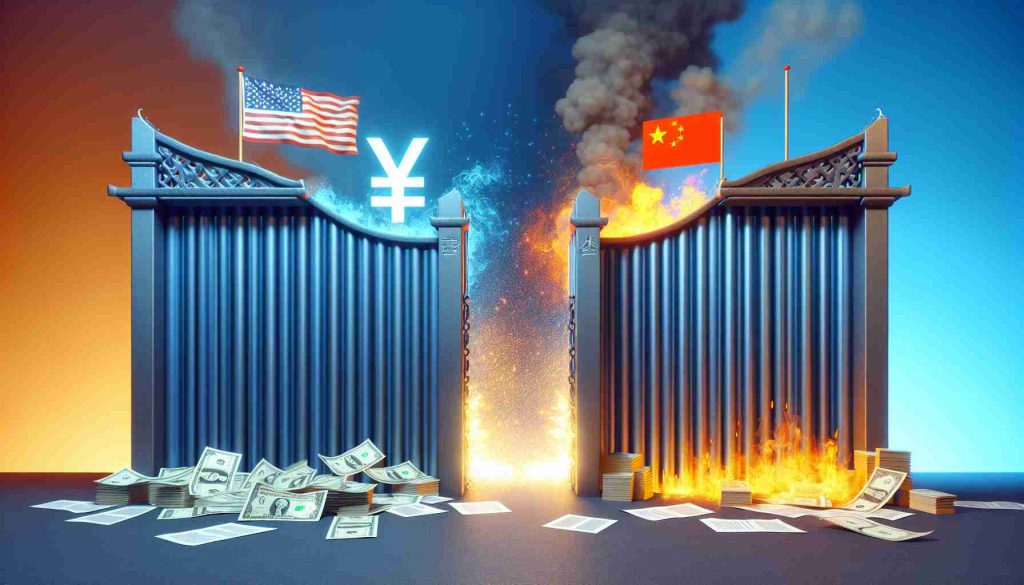- Trump’s trade battle with China has intensified, marked by increasing tariffs from both nations.
- China retaliated with tariffs on U.S. coal, liquefied natural gas, crude oil, and machinery, alongside export controls on critical minerals.
- China claims that U.S. tariffs violate World Trade Organization rules, potentially undermining global economic cooperation.
- The U.S. has eliminated a tariff exemption for Chinese goods valued under $800, impacting retailers like Shein.
- Despite potential consumer pain, Trump views tariffs as a strong means to boost the U.S. economy.
- The conflict highlights the fragile state of international trade and its far-reaching consequences for consumers and economies worldwide.
In a dramatic escalation of tensions, Donald Trump has launched his trade battle against China, unleashing a wave of tariffs that swiftly provoked a fierce response from Beijing. As the U.S. imposed a 10% tariff on a range of goods, China fired back with its own sanctions, threatening to disrupt global trade and economics.
As the dust settled, China’s finance ministry announced a 15% tariff on coal and liquefied natural gas imports from the U.S., alongside 10% tariffs on crude oil and various machinery. This move followed an investigation into Google, indicating a significant shift in trade dynamics. Additionally, several critical minerals were placed under strict export controls by China, targeting U.S. interests directly.
In a pointed remark, China’s finance ministry condemned U.S. actions as a breach of World Trade Organization rules, asserting that these tariffs would only harm economic cooperation. Meanwhile, the U.S. has halted an important tariff exemption benefiting popular Chinese retailers like Shein that had allowed goods valued under $800 to enter tariff-free.
While negotiations with Canada and Mexico offered some reprieve from his fiery stance, Trump remained adamant that tariffs serve as a potent tool for economic leverage. He acknowledged the potential for “a little pain” for American consumers, but his vision for revitalizing the economy was unwavering.
This escalating conflict illustrates the precarious nature of international trade relations, and the stakes could not be higher. The key takeaway? As Trump presses forward, consumers and economies worldwide brace for the ripple effects of this burgeoning trade war.
Trade Wars 2.0: What You Need to Know About the Escalating U.S.-China Tensions
Understanding Current Trade Dynamics between the U.S. and China
The ongoing trade battle between the United States and China represents not just a clash of tariffs but also a broader contest that affects global markets, supply chains, and geopolitical alliances. As both nations impose tariffs and sanctions, industries across the globe are experiencing shifts that may redefine international trade environments. Here are some key aspects of this conflict.
# Key Features of the Trade War
– Tariff Specifics: The most recent changes include a 10% tariff on various goods from the U.S. and a 15% tariff on coal and LNG imports from the U.S. into China. These tariffs selectively target industries and products, influencing global supply chains.
– Export Controls: China has tightened controls on critical minerals, particularly those vital for technology and manufacturing, which could severely impact U.S. tech companies.
– Global Economic Impact: The ongoing trade war has implications beyond just China and the U.S.; it affects economies globally as countries navigate their own trade policies in response to these escalating tensions.
# Pros and Cons of the Ongoing Trade War
Pros:
– The tariffs may protect certain U.S. industries from foreign competition.
– They can lead to a renegotiation of trade terms to favor U.S. interests.
Cons:
– Increased prices for consumers due to tariffs on imported goods.
– Potential disruptions in global supply chains affecting multiple sectors.
# Predictions for the Future
– Market Forecasts: Experts predict that if the current tariffs remain in place, both U.S. and Chinese economic growth could slow significantly, with the potential for a recession in industries heavily reliant on trade.
– Consumer Behavior: Analysts suggest that consumers may shift preferences towards domestic products to avoid higher tariffs on imported goods, leading to changes in market dynamics.
Frequently Asked Questions
Q1: How do tariffs impact the average American consumer?
A1: Tariffs often result in higher prices for imported goods. Consumers may face increased costs on products that they traditionally purchase, which can lead to inflation and reduced disposable income.
Q2: What are the long-term implications of the U.S.-China trade war on global markets?
A2: Long-term implications may include a restructuring of global supply chains as companies seek to diversify sourcing to mitigate risks associated with tariffs. This could lead to reduced trade volumes between the U.S. and China and shifts towards markets in Southeast Asia and beyond.
Q3: Are there any potential resolutions to this trade war?
A3: While negotiation continues to be a possibility, both countries’ interests are significantly at odds. Structural changes in trade practices may take time, and ongoing political considerations can complicate potential agreements.
Additional Insights into Trade and Economy
The complexities of the U.S.-China trade relationship extend far beyond tariffs. Innovations in technology, shifts in consumer preferences, and sustainability goals are all factors that businesses must now consider within this increasingly fraught atmosphere.
To stay updated on these developments, visit CNBC, which provides ongoing analysis and reporting on the evolving economic landscape and trade negotiations.
